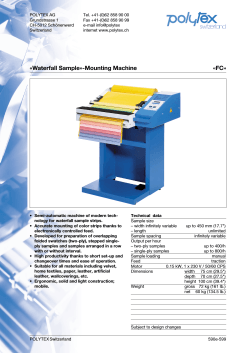
02-201 / 02-601 — Assignment 3 – Due Tuesday, Sep....
02-201 / 02-601 — Assignment 3 – Due Tuesday, Sep. 23 at noon Cellular automata (CAs) are a simplified model of physics and complex systems that has been studied for many years. One-dimensional CAs are defined by the following rules: • The “universe” is an infinitely long line of “cells.” • Each “cell” can either be filled or empty. • The state of a cell i at time t depends on the states of cells i − 1, i, and i + 1 at time t − 1. The rule for how cell i depends on these cells defines the particular CA you are studying. The rules are represented by diagrams of the following type: For example, the first part of the rule above means that if cell i − 1, i and i + 1 are all filled at time t − 1, then at time t, cell i will be filled. All the sub rules (boxes above) are applied simultaneously during a single step. The interesting thing about CAs is that they can give surprisingly complex behavior. For example, the rule above produces the pattern on the left: The rule Produces the pattern on the right above, something even more complex. 1 The Assignment Input. You will write a program that takes in a CA rule and produces a given number of iterations of the CA. Your command should be able to be run using the following command line: go run ca.go RULE WIDTH STEPS Where STEPS is the number of steps to run the CA. Since we can’t work with an infinitely long sequence of cells, we will only model WIDTH cells. Finally, RULE is a sequence of 8 ’0’s and ’1’s that give the outcome of each subrule in the order used in the examples above. For example, the rule: would be given as “11111010” and the rule would be given as “01011010”. Output. At each step, you should output the state of the cells. You should print an empty cell as a single space and a filled cell as a # character as in the examples above. You should output the state of the cells at the start too. Your cells should initially all be empty, except for the cell at bWIDTH/2c, which should be filled. (The bxc notation means throw about the fractional part of x.) If any of the command line parameters are not valid, you should output an error message that begins with Error: and stop the program. Your program should assume that any cells outside of the WIDTH cells you are modeling are empty forever. That is you are just modifying cells 0 . . . WIDTH − 1. The set up thus looks like this: WIDTH alw alw ays ays em em pty pty STEPS 2 Learning outcomes After completing this assignment, you should: • be able to create arrays. • be able to walk through the items in an array. • be able to access characters in a string. • have gained additional practice writing for loops, if statements, and functions. • have practiced writing code with good “style” (formatting, modularity, comments). Extra Credit! Allow your program to accept two formats for the rule. The first format is the 0/1 string above. The second format is a number between 0 and 255 whose binary representation gives the string of 0s and 1s. 3
© Copyright 2025





















